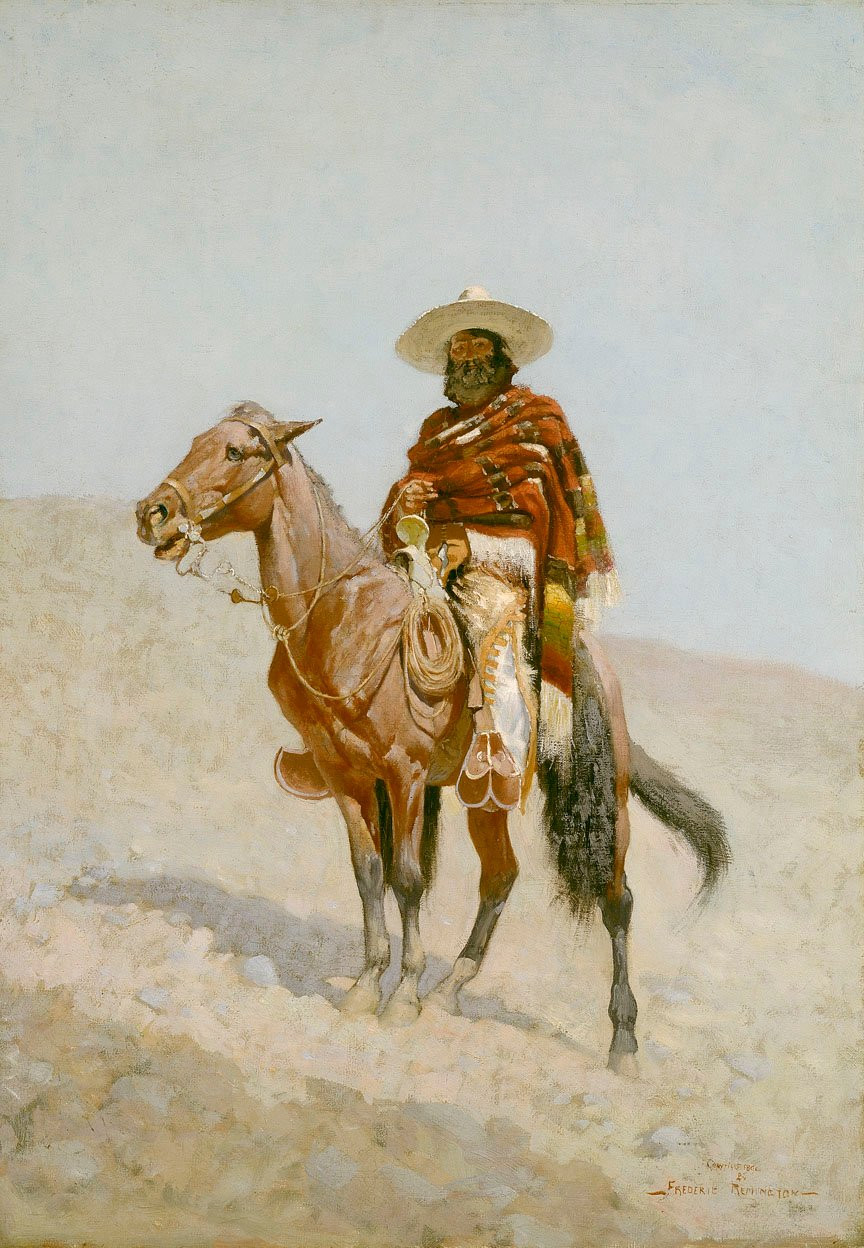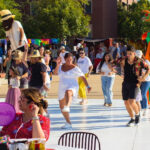A Mexican Vaquero, more than just a cowboy, is a symbol of Mexican heritage, deeply rooted in horsemanship, cattle ranching, and unique cultural traditions, making them a captivating subject for exploration on gaymexico.net. This article delves into the world of the vaquero, exploring their historical origins, skills, attire, and enduring legacy within Mexican culture, and the LGBTQ+ community’s connection to it, offering valuable insights for travelers and enthusiasts alike. Discover LGBTQ+ friendly travel tips, events, and destinations as you explore the world of the vaquero.
1. Who is a Mexican Vaquero?
A Mexican vaquero is a skilled horseman and cattle herder, integral to the ranching traditions of Mexico. The vaquero, the precursor to the American cowboy, represents a rich heritage of horsemanship, roping skills, and a deep connection to the land.
1.1 What are the Origins of the Vaquero Tradition?
The vaquero tradition traces its origins back to 16th-century Spanish conquistadors who brought horses and cattle to Mexico. These early Spanish settlers developed ranching practices that were later adopted and adapted by the indigenous population and mestizos, giving rise to the vaquero culture. According to research from the University of Texas at Austin, the vaquero tradition is a blend of Spanish equestrian skills and indigenous knowledge of the land.
1.2 How Does the Vaquero Differ from the American Cowboy?
While both vaqueros and American cowboys share a common ancestry, distinct differences exist in their techniques, attire, and cultural significance. Vaqueros emphasize horsemanship and cattle handling, often using traditional methods like roping and reining, while the American cowboy culture, influenced by various European and American traditions, evolved with its own distinct style. As noted in “The Cowboy’s Trail Guide” by Texas Tech University, vaqueros often use a longer rope and a different saddle design compared to their American counterparts.
1.3 What Role Did Vaqueros Play in the History of the American West?
Vaqueros played a crucial role in shaping the ranching industry in the American West. As the Spanish expanded northward, vaqueros accompanied them, bringing their expertise in cattle handling and horsemanship. Their techniques and tools were adopted by Anglo-American settlers, contributing to the development of the cowboy culture in the United States. According to the National Cowboy & Western Heritage Museum, many of the terms and practices associated with cowboys, such as “lariat” (from “la reata”) and “buckaroo” (from “vaquero”), are of Spanish origin.
 A Mexican Vaquero
A Mexican Vaquero
A painting capturing the essence of a Mexican vaquero on horseback.
2. What Skills and Techniques Define a Mexican Vaquero’s Expertise?
A Mexican vaquero’s expertise is defined by a combination of horsemanship, roping skills, and knowledge of cattle handling. These skills are honed through years of experience and passed down through generations.
2.1 What Horsemanship Skills are Essential for a Vaquero?
Horsemanship is at the core of a vaquero’s skills. Vaqueros must have a deep understanding of equine behavior and be able to communicate effectively with their horses. Essential horsemanship skills include:
- Reining: Guiding the horse with subtle cues from the reins, legs, and body weight.
- Neck Reining: Steering the horse by applying the rein to the opposite side of the neck.
- Collection: Achieving a balanced and responsive frame in the horse.
- Working Cattle: Moving and controlling cattle with precision and agility.
2.2 What Roping Techniques do Vaqueros Employ?
Roping is another fundamental skill for vaqueros, used for various tasks such as branding, vaccinating, and doctoring cattle. Vaqueros typically use a long rope, known as a “reata,” made from braided rawhide or nylon. Key roping techniques include:
- Dally Roping: Wrapping the rope around the saddle horn to secure the animal.
- Heel Roping: Roping the hind legs of the animal.
- Head Roping: Roping the head or horns of the animal.
- Team Roping: Working with a partner to rope and control the animal.
2.3 How Do Vaqueros Handle Cattle?
Vaqueros employ specialized techniques to handle cattle effectively and humanely. These techniques are based on understanding cattle behavior and minimizing stress on the animals. Important cattle handling skills include:
- Cutting: Separating individual animals from the herd.
- Driving: Moving the herd from one location to another.
- Penning: Confining cattle in a designated area.
- Sorting: Separating cattle based on specific criteria, such as age, sex, or health.
3. What Does a Mexican Vaquero’s Attire Consist Of?
A Mexican vaquero’s attire is both functional and stylish, reflecting the demands of their work and the cultural traditions of Mexico. Each garment and accessory serves a purpose, while also adding to the vaquero’s distinctive appearance.
3.1 What Type of Hat Does a Vaquero Wear?
The vaquero hat, known as a “sombrero,” is an iconic part of their attire. Sombreros are typically made of felt or straw and feature a wide brim to protect the vaquero from the sun and rain. The shape and style of the sombrero can vary depending on the region and personal preference.
3.2 What are the Characteristics of a Vaquero’s Jacket and Shirt?
Vaqueros often wear jackets made of leather or denim for protection against the elements. Shirts are typically made of cotton or linen and can be either plain or decorated with embroidery. Some vaqueros wear a “cuera,” a long, fringed leather jacket that provides additional protection and style.
3.3 What Kind of Pants and Boots Do Vaqueros Typically Wear?
Vaqueros wear durable pants made of denim or heavy cotton. These pants are often reinforced with leather patches on the inner legs to protect against wear and tear from riding. Vaquero boots are typically made of leather and feature a high heel and pointed toe. The high heel helps to keep the vaquero’s foot securely in the stirrup, while the pointed toe allows for easy insertion into the stirrup.
4. What is the Cultural Significance of the Mexican Vaquero?
The Mexican vaquero is more than just a skilled horseman; they are a cultural icon representing the traditions, values, and history of Mexico. The vaquero embodies a strong work ethic, independence, and a deep connection to the land.
4.1 How Does the Vaquero Symbolize Mexican Identity?
The vaquero is deeply intertwined with Mexican identity, symbolizing the country’s rich agricultural heritage and independent spirit. Vaqueros are often romanticized in Mexican folklore, music, and art, representing a simpler way of life and a strong connection to nature.
4.2 What Influence Does the Vaquero Have on Mexican Music and Art?
The vaquero has had a significant influence on Mexican music and art. Many traditional Mexican songs, such as “corridos” and “rancheras,” tell stories of vaqueros and their adventures. In art, vaqueros are often depicted in paintings, sculptures, and murals, capturing their skills, attire, and lifestyle.
4.3 How Does the Vaquero Image Impact Mexican Cinema and Literature?
The vaquero image is prevalent in Mexican cinema and literature, portraying them as heroes, adventurers, and symbols of national pride. Films and novels often depict vaqueros as skilled horsemen, brave fighters, and defenders of justice.
5. Where Can You Experience Vaquero Culture in Mexico?
Experiencing vaquero culture in Mexico offers a unique opportunity to immerse yourself in the traditions, skills, and lifestyle of these iconic figures. From attending rodeos to visiting working ranches, there are numerous ways to witness and participate in vaquero culture.
5.1 What are Some Popular Vaquero Festivals and Rodeos in Mexico?
Mexico hosts several vaquero festivals and rodeos throughout the year, showcasing the skills and traditions of vaqueros. Some popular events include:
- Feria de San Marcos: Held in Aguascalientes, this annual fair features bullfighting, charrería (Mexican rodeo), and other cultural events.
- Campeonato Nacional Charro: This national charrería championship brings together the best charros (vaqueros) from across Mexico to compete in various events.
- Fiestas de Octubre: Held in Guadalajara, this month-long festival includes charrería performances, concerts, and cultural exhibitions.
5.2 Can You Visit Working Ranches and Learn Vaquero Skills?
Several working ranches in Mexico offer visitors the opportunity to experience the vaquero lifestyle firsthand. These ranches provide accommodations, meals, and activities such as horseback riding, cattle handling, and roping lessons. Some popular ranch destinations include:
- Hacienda de San Antonio: Located in Jalisco, this historic hacienda offers horseback riding tours and cattle drives.
- Rancho Las Cascadas: Situated in Guanajuato, this ranch offers guests the chance to participate in daily ranch activities, such as herding cattle and working with horses.
- Estancia Vik José Ignacio: Found in Uruguay, near Mexico, this estancia offers visitors a glimpse into traditional ranch life, with opportunities for horseback riding and cattle work.
5.3 What Museums and Cultural Centers Showcase Vaquero History?
Several museums and cultural centers in Mexico showcase the history and traditions of vaqueros. These institutions feature exhibits on vaquero attire, tools, and techniques, as well as the role of vaqueros in Mexican history and culture. Some notable museums include:
- Museo de la Charrería: Located in Mexico City, this museum is dedicated to the history and traditions of charrería.
- Museo del Sarape y Trajes Regionales: Situated in Saltillo, this museum features exhibits on traditional Mexican clothing, including vaquero attire.
- Museo Regional de Guadalajara: Found in Guadalajara, this museum showcases the history and culture of the Jalisco region, including its vaquero heritage.
6. How Has the Vaquero Tradition Evolved Over Time?
The vaquero tradition has evolved over time, adapting to changing economic, social, and technological conditions. While some traditional practices remain, vaqueros have also embraced new techniques and tools to improve their efficiency and sustainability.
6.1 How Did Modernization Impact Vaquero Practices?
Modernization has had a significant impact on vaquero practices. The introduction of new technologies, such as tractors, trucks, and helicopters, has reduced the need for some traditional skills. However, vaqueros have also adapted to these changes, using new technologies to improve their efficiency and manage larger herds.
6.2 Are There Contemporary Vaqueros in Mexico Today?
Despite modernization, contemporary vaqueros continue to play an important role in Mexico’s ranching industry. Many vaqueros still work on traditional ranches, preserving the skills and traditions of their ancestors. Others have found employment in related fields, such as equine training, rodeo, and tourism.
6.3 How Are Vaquero Traditions Being Preserved?
Several organizations and individuals are working to preserve vaquero traditions for future generations. These efforts include:
- Charrería Federations: These organizations promote and regulate charrería, ensuring that traditional skills and values are passed down to younger generations.
- Vaquero Associations: These groups organize events, workshops, and educational programs to promote vaquero culture and skills.
- Ranching Families: Many ranching families are committed to preserving their vaquero heritage, teaching their children and grandchildren the skills and values of their ancestors.
7. What are the Key Differences Between Vaqueros and Charros?
While often used interchangeably, vaquero and charro have distinct meanings and represent slightly different aspects of Mexican equestrian culture.
7.1 Defining the Charro: More Than Just a Cowboy
The charro is a skilled horseman who participates in charrería, a competitive equestrian sport that originated in Mexico. Charrería involves a series of events that showcase the skills of the charro, such as roping, riding, and cattle handling.
7.2 Charrería: The Formalization of Vaquero Skills
Charrería can be seen as a formalization of vaquero skills, with specific rules and regulations governing each event. Charros typically wear elaborate traditional attire, including embroidered suits, sombreros, and boots.
7.3 Vaquero vs. Charro: Distinctions in Role and Representation
While vaqueros are primarily ranch workers who focus on cattle handling and horsemanship, charros are competitive athletes who participate in charrería. Vaqueros represent a more traditional, rural lifestyle, while charros embody a more stylized, competitive form of equestrian culture.
8. Where Can LGBTQ+ Travelers Experience Vaquero Culture?
LGBTQ+ travelers can experience vaquero culture in Mexico by seeking out LGBTQ+-friendly establishments and events that celebrate Mexican traditions.
8.1 LGBTQ+-Friendly Ranch Stays and Cultural Tours
Some ranches and tour operators in Mexico cater specifically to LGBTQ+ travelers, offering a welcoming and inclusive environment for experiencing vaquero culture. These establishments often provide opportunities for horseback riding, cattle handling, and cultural immersion, while also ensuring a safe and respectful atmosphere for LGBTQ+ individuals.
8.2 Supporting Inclusive Charrería Events
While charrería is a traditional sport, some events are becoming more inclusive of LGBTQ+ participants and spectators. Look for charrería events that promote diversity and inclusion, and support teams and individuals who are open and welcoming to LGBTQ+ people.
8.3 LGBTQ+ Vaquero Communities and Allies
Connect with LGBTQ+ vaquero communities and allies in Mexico to learn more about their experiences and find opportunities to participate in vaquero culture. These communities can provide valuable insights and support for LGBTQ+ travelers interested in exploring this aspect of Mexican heritage.
9. What are Some Misconceptions About Mexican Vaqueros?
Several misconceptions surround Mexican vaqueros, often perpetuated by popular culture and stereotypes.
9.1 Debunking the Myth of the “Bandit” Vaquero
One common misconception is that vaqueros were primarily bandits or outlaws. While some vaqueros may have engaged in illegal activities, the vast majority were hardworking individuals who played an important role in Mexico’s ranching industry.
9.2 Beyond Machismo: The Real Vaquero Values
Another misconception is that vaquero culture is inherently macho and excludes women and LGBTQ+ individuals. While traditional vaquero culture may have been male-dominated, contemporary vaqueros are increasingly embracing diversity and inclusion.
9.3 Vaqueros: More Than Just a Relic of the Past
Many people view vaqueros as a relic of the past, but contemporary vaqueros continue to play an important role in Mexico’s ranching industry and cultural landscape. Vaquero traditions are being preserved and adapted for future generations, ensuring that this unique cultural heritage remains vibrant and relevant.
10. How Can You Learn More About Vaquero Culture Through gaymexico.net?
Gaymexico.net offers a wealth of information and resources for LGBTQ+ travelers interested in learning more about vaquero culture in Mexico.
10.1 Travel Guides to Vaquero Regions in Mexico
Gaymexico.net provides travel guides to vaquero regions in Mexico, highlighting LGBTQ+-friendly accommodations, events, and cultural attractions. These guides offer valuable insights and recommendations for planning your trip and experiencing vaquero culture in a safe and welcoming environment.
10.2 Articles and Stories on LGBTQ+ Vaquero Experiences
Gaymexico.net features articles and stories on LGBTQ+ vaquero experiences, showcasing the diversity and resilience of LGBTQ+ individuals who are passionate about vaquero culture. These stories offer a unique perspective on the intersection of LGBTQ+ identity and Mexican heritage.
10.3 Connecting with LGBTQ+ Vaquero Communities Online
Gaymexico.net provides a platform for connecting with LGBTQ+ vaquero communities online, allowing you to share your experiences, ask questions, and find support. These communities can help you learn more about vaquero culture and find opportunities to participate in events and activities.
 A Mexican Vaquero
A Mexican Vaquero
A group of Mexican vaqueros pose for a portrait on their horses.
FAQ About Mexican Vaqueros
1. What is the origin of the word “vaquero?”
The word “vaquero” comes from the Spanish word “vaca,” meaning cow. Therefore, a vaquero is literally a “cow man.”
2. What is charrería?
Charrería is a competitive equestrian sport that evolved from the working skills of vaqueros. It is considered the national sport of Mexico.
3. What are some essential tools of a vaquero?
Essential tools include a horse, saddle, rope (reata), spurs, and appropriate clothing for protection.
4. How has modernization affected the vaquero lifestyle?
Modernization has brought technology like trucks and tractors, reducing the need for some traditional skills but also introducing new methods for managing larger herds.
5. Are there still vaqueros today?
Yes, contemporary vaqueros continue to work on ranches in Mexico, preserving their traditions and skills.
6. What is the difference between a vaquero and a cowboy?
While both share similar origins, vaqueros are rooted in Spanish traditions with distinct techniques, attire, and cultural significance compared to American cowboys.
7. How can I experience vaquero culture in Mexico?
You can attend vaquero festivals and rodeos, visit working ranches that offer immersive experiences, and explore museums and cultural centers showcasing vaquero history.
8. What misconceptions exist about Mexican vaqueros?
Common misconceptions include portraying vaqueros as bandits and assuming vaquero culture is strictly macho, which overlooks the diversity and evolving values within the community.
9. How does the vaquero symbolize Mexican identity?
The vaquero embodies Mexican identity through their representation of agricultural heritage, independent spirit, and connection to the land, often romanticized in folklore, music, and art.
10. How does gaymexico.net support LGBTQ+ travelers interested in vaquero culture?
Gaymexico.net offers travel guides to vaquero regions, articles on LGBTQ+ vaquero experiences, and platforms for connecting with LGBTQ+ vaquero communities online, ensuring inclusive exploration of Mexican heritage.
Ready to explore the captivating world of the Mexican vaquero? Visit gaymexico.net for detailed travel guides, insider tips, and LGBTQ+-friendly recommendations to make your journey unforgettable. Discover the vibrant culture, breathtaking landscapes, and welcoming communities that await you in Mexico. Connect with us today and start planning your adventure. Address: 3255 Wilshire Blvd, Los Angeles, CA 90010, United States. Phone: +1 (213) 380-2177.

